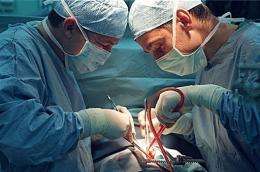New software provides 3-D views of arteries in catheterization lab

New technology that allows doctors to see three-dimensional images of heart arteries in the catheterization lab passed its first major testing hurdle — moving doctors closer to understanding its impact on clinical practice, researchers report in Circulation: Cardiovascular Interventions, an American Heart Association journal.
Still in the early stages of testing, the 3-D images may allow cardiologists to more accurately and quickly assess the length, branching pattern, and angles of heart arteries and any blockages.
"Coronary interventions may be improved by having a realistic, 3-D image of the coronary artery tree," said John. D. Carroll, M.D., an investigator for the study and professor of medicine and director of interventional cardiology in the Division of Cardiology at the University of Colorado in Aurora, Colo.
Currently, doctors take multiple two-dimensional X-ray images from different views to visualize what the arteries look like inside the body. The new software, which uses existing X-ray systems, could reduce the need for multiple X-rays, thus decreasing patients' exposure to radiation and contrast dye and cutting the time doctors spend analyzing the images.
During a cardiac catheterization procedure, doctors insert a thin tube called a catheter into a patient's leg artery, then thread it up to the heart. The catheter is then used to inject contrast dye that temporarily fills the coronary arteries allowing x-ray visualization of the inner diameter of the artery. This allows doctors to detect plaque build up, then plan and execute, if needed, the insertion of a coronary stent to open a blocked artery and allow normal blood flow. X-rays are generated below the patient and 2-D shadow-like images of coronary arteries are created by a detector above the patient. These shadow images have been the standard method of presenting coronary angiographic images for over 50 years.
In the study, researchers compared these standard 2-D images to automatically generated, computer-reconstructed 3-D images of 23 patients' coronary artery systems. To generate realistic 3-D images, the detector was rapidly rotated around the patient during the injection of contrast dye, a technique called rotational angiography.
"This is the first in-human use," Carroll said about the feasibility study. "The next step is to test it in multiple centers around the world. In addition, we'll formally test it to see the impact on clinical care. The bottom line is that this is very exciting technology that holds great promise."





















